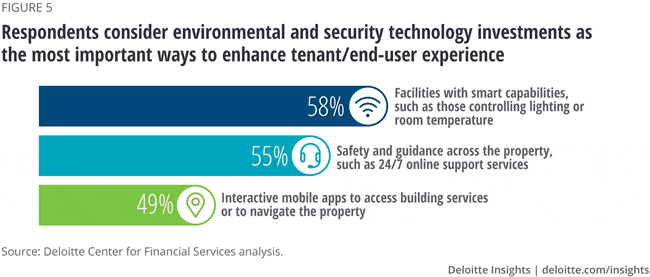The commercial real estate (CRE) industry is a complex ecosystem with multiple stakeholders and traditionally has been rather slow in adopting new technologies, just like the construction industry.
Yet, things are evolving, and the commercial real estate industry has started to go through a digital transformation. Especially in commercial buildings, the human experience – tenant experience in this case – once again, is one of the key elements and drivers of the developments taking place.
An overview of the main changes in the commercial real estate industry and why realizing smart buildings and green buildings becomes more important for investors, property developers, corporate occupiers, building and facility services providers, and other stakeholders.
It has become urgent for commercial real estate companies to prioritize tenants’ and end users’ needs, given the increasing influence of technology and changing customer preferences (Deloitte)
The cause of these changes are numerous and don’t just impact the priorities with regards to commercial buildings but also fit in the evolutions of the CRE industry overall, the strategic shifts of services companies, the growing PropTech (property technology or real estate technology) startup market, and technological evolutions in related markets such as the earlier mentioned construction industry. In this first article, we start with the tenant experience.
The drivers of digitization and transformation in the commercial real estate industry
As such, technologies aren’t new in commercial buildings and the built environment overall. We’ve been covering the usage of the Internet of Things, convergence of IT and OT, and ample new and maturing technologies such as AI, building information modeling, augmented reality, digital twins, big data, cloud computing, and many others in the scope of areas such as building management, the evolution of retail facilities, construction, and so on.

Yet, here we take a broader view of the commercial real estate industry overall, especially the commercial buildings market.
An overview of some of the elements that drive the digitization and transformation of the real estate industry:
- The tenant experience ranks first, with an increasing focus on digital experiences and services. Tenant experience is also one of the main drivers of the PropTech scene and the key topic of this article.
- Sustainability ranks high on the agenda of investors and developers, too, not just because of changing regulations and demographic shifts as we’ve seen in other areas but also from the valuation perspective and the demands of corporate occupiers. Within the scope of experience and sustainability, you can also add health and well-being with ‘healthy buildings.’
- From a risk perspective, there is an increasing need for safety, physical and electrical security, and cybersecurity. Physical security and cybersecurity are important from a technology investment perspective as you’ll read below. And, especially in the context of facilities which we tackled before (think about healthcare facilities and technologies in the hotel industry) and where ‘newer’ technologies are key game changers, you can add privacy to that equation as well.
- In the scope of asset valuation, there’s an increasing focus on the digital, smart and connected commercial building aspect (which of course, is related to shifting priorities of various stakeholders and needs to be seen together with the other drivers) and the sustainable aspect.
- Although we could say they are highly interconnected with other goals as well and even add them to the next element, we mention space management and surface optimization separately since it’s a topic we’ll dive deeper into later.
- Lastly, there is the importance, among others in the context of asset valuation and some of the other goals, to decrease costs, increase efficiency and since this, and other priorities, that goes hand in hand with technologies such as the Internet of Things, big data analytics and artificial intelligence, and the gradual realization there are new opportunities to leverage data to create additional value whereby building information modeling again can be mentioned as a game-changer.
Since we talked about healthcare facilities, hotels, industrial facilities, and, within that context the importance of, among others, the human experience and smarter technologies, we’ll mainly zoom in on smart office buildings and some other types of commercial buildings for this overview.
The real estate market is expecting sustainable properties and commercial buildings that meet “Green Building” standards
The commercial real estate industry and tenant experience
In an interview on the real estate EcoXpert program and its drivers, Hugh Lindsay and Youcef Gharoual from Schneider Electric tackle all the mentioned evolutions in detail, zooming in on each one of them with examples and insights into how they see the shifts happening in practice, including ways to address them.
The real estate specialization enables partners who follow it to come with solutions that cover many of the cited needs of the real estate industry, for instance guiding their customers on the path towards green building and sustainability certifications (LEED, BREEAM,…), based on the lessons the company learned in achieving a high level of certification for its new buildings in Grenoble (France). Yet, it’s just not about sustainability – the interview contains plenty of insights on how other needs can be met as well, so stay tuned.
Having a real estate smart building value proposition, Schneider Electric organized an expert learning session with CRE experts from Deloitte, BNP Real Estate, and research firm Verdantix (moderated by Schneider’s Cormac Crossan). The panel offered quite some insights on the evolutions we summed up earlier as well – also on the tenant experience and the workforce (at the bottom of this article, you can see the full expert learning session).
Speaking about Deloitte (of whom Schneider Electric is a client and to whom Schneider supplies technologies for some of their smartest buildings, notably The Edge in Amsterdam – called the world’s greenest building in 2015 – and the Majunga Tower in Paris as is reminded in the expert learning session): for its 2020 commercial real estate outlook, the company surveyed 750 commercial real estate executives and found that most of them rated tenant experience as a top priority.
The outlook, that assesses how and to what extent emerging technologies and analytics help leaders make more informed location decisions and create a more memorable tenant experience, also found that tenant experiences are changing.
Contributing factors: increasing urbanization and globalization, changing workforce demands, and technological advancements in some of the mentioned areas.
The human experience seems to be everywhere in business goals these days. And it’s the same in all kinds of buildings. One can say that a smart building that doesn’t focus on enhancing the experiences of the people working, staying and living in them aren’t that smart.
For hotels, it’s the guest experience, for hospitals the patient experience and for companies the employee experience in today’s modern office buildings with new workspace and hybrid work approaches that play a role in attracting and retaining talent – which as Hugh and Youcef reminded in our interview, has also driven demand for such solutions from HR in these days of digital HR and an evolving future of work.
Wherever you look in the built environment, from buildings to cities (citizen experience), people’s experiences are becoming essential. It partially has to do with a shift in behavior and expectations as a result of our digital lifestyles and with changing demographics. The commercial real estate industry sees the evolutions and starts investing in new initiatives and technologies accordingly. Moreover, smart buildings and smart cities go hand in hand, as we see in the interview with Hugh and Youcef.
Towards digital tenant experiences in commercial buildings
Obviously there’s always a link with efficiency and value. But as in many industries, the road to creating more value runs across efforts to enhance well-being and experiences too.
The links between experiences and value are well-known in many sectors and situations. Enhancing employee experience, for instance, is known to have an impact on productivity and the bottom line, as well as on customer experience. A better shopper experience in retail facilities drives revenues and loyalty. And improving patient experience has an impact on the overall quality of healthcare but also on the average length of stay in a hospital as you can read here, to give some examples.
With a new generation of workers, the expectations for workspace dynamics that focus on activity-based workplace and customizable spaces and amenities have grown
So, it doesn’t come as a surprise that the tenant experience is one of the cornerstones in the transformational priorities the commercial real estate industry, in a world where people’s experiences rank high on the agenda of organizations’ goals and digital transformation largely revolves around optimizing these experiences across industries.
And in all these different types of buildings where experiences gain importance, technologies are used as enablers. Across various industries, the picture of leveraging technology – and thus data – looks quite similar in fact. The Internet of Things deliver the data that is needed to not just enhance efficiency but also create the systems enabling those better experiences, and big data analytics help turn the information and knowledge from the data into decisions, automated actions and a new range of apps and potential integrations between siloed systems or with new systems. And the data, in turn, enable new value propositions and services.
In its 2020 commercial real estate outlook, Deloitte states that it is becoming more urgent for CRE companies to prioritize tenants’ and end-users’ needs, given the increasing influence of technology and changing customer preferences. The commercial real estate industry’s mantra, ‘location, location, location’ first evolved into ‘location, information, analytics’ a few years ago, emphasizing the importance of data and analytics. Now it’s ‘location, experience, analytics,’ Deloitte says.

For a majority of CRE executives, digital tenant experience is not a core competency (yet). However, 64 percent said they increased tenant experience–related technology investments over the past 18 months. IoT- enabled smart capabilities and mobile apps are among the two most important ways to enhance tenant/end-user experience, Deloitte found, while respondents consider environmental and security technology investments as the most important ways to enhance that experience as the figure from the report above show.

